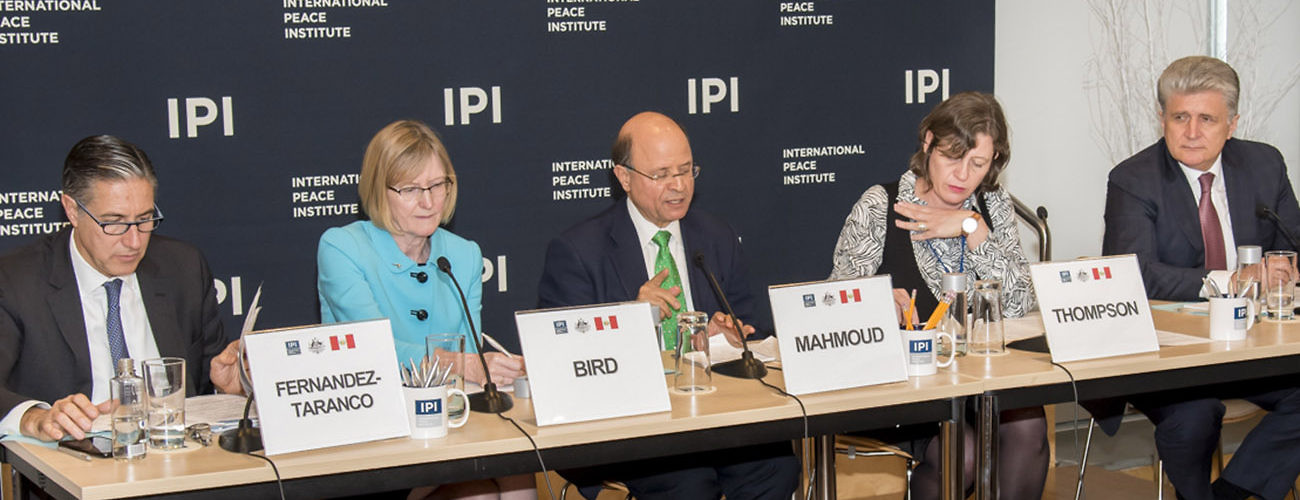A broad group of member states, United Nations officials, civil society, academia and members of the public gathered at IPI on February 27th, 2018 to discuss how to interpret and take forward the recommendations of the January 2018 Secretary-General’s report on peacebuilding and sustaining peace.
Oscar Fernandez-Taranco, Assistant Secretary-General of the UN Peacebuilding Support Office (PBSO), began the conversation by pointing out why it was important now to devote high level attention to the subject. “Peacebuilding was still often left as an afterthought–under-recognized, under-prioritized, under-resourced and in the meantime the failure to successfully prevent the lapse and relapse into conflict was having irreversible repercussions for the credibility of the global action and the reputation of the United Nations,” he said.
That lack of attention began to change with the passage in April 2016 of substantively identical resolutions in the Security Council and the General Assembly that introduced the concept of sustaining peace as an overarching goal of peacebuilding processes. “The adoption of these twin resolutions demonstrated that member states were ready to stand up to this challenge, and I think now is where the UN needs to respond quite forcefully,” Mr. Fernandez-Taranco said.
In his intervention, he chose to focus on the key leadership role UN member states need to play to take forward the concept of sustaining peace as a goal and process. “National ownership, of course, is at the heart of these efforts,” he said. “Peacebuilding and sustaining peace is primarily the responsibility of member states, but the importance of inclusivity and people-centered approaches resonate throughout this report.”
Gillian Bird, Permanent Representative of Australia to the UN, praised the report, but said that in order to maintain the momentum generated by the Secretary-General report, another report may be necessary. “There’s currently no mandate for further reporting on sustaining peace implementation,” she said. “If we don’t create action for a mandate and for a new report, there won’t be one.”
Katy Thompson said that in her role as a Team Leader in Conflict Prevention, Governance and Peacebuilding, at the UN Development Programme (UNDP), she has gained invaluable perspective on how to enable the sustaining peace agenda from colleagues worldwide.
“The conversation now [on sustaining peace], really needs to move out of New York…to our colleagues who are working at country-level, where the critical mass of the UN sits,” she said. The UN should “provide them with that kind of support that we’ve outlined; that will enable the sustaining peace agenda to really withstand the test of time.”
Picking up on that same point, Miroslav Jenča, Assistant Secretary-General, UN Department of Political Affairs (DPA), said that true measure of the success of the sustaining peace concept will be when “it shows results on the ground.”
“Sustaining peace is only useful as a concept if we can point to evidence that it makes a difference in the lives of the people we serve,” he said. “It is also only as useful in terms of how much it builds national ownership on the ground.”
He also encouraged member states to follow through on the recommendation of the Secretary-General’s report for “more systematic integrated analysis leading to better early warning and planning.”
Ismael A. Gaspar Martins, Permanent Representative of Angola to the UN, echoed the point about sustaining peace being more than a concept, and being tested by its local impact. “We need to take this discussion to the ground, and to the field,” he said.
Gustavo Meza-Cuadra Velásquez, Permanent Representative of Peru to the UN, suggested his country could serve as a model of sustaining peace in practice. Peru, having suffered through two decades of terrorism, has “passed from two decades of chronic instability to the consolidation of our democracy and an unprecedented period of economic growth and poverty eradication,” he said.
Acknowledging that there is no one-size-fits-all approach to making peace, he attributed the success in his country to “a wide national consensus on the need to address the root causes of conflict through an integral approach, entailing peace and security development and human rights policies and concrete measures, as well as, strengthening accountable and inclusive societies.” He added that the full participation the private sector, civil society, women and youth in the process had been essential.
Masud Bin Momen, Permanent Representative of the People’s Republic of Bangladesh to the UN, urged officials to keep the emphasis on peace, rather than conflict. “In order for the notion to gain further traction, we should keep working and allow the time for all member states to see the merit of this paradigm shift in our common vision for peace. One possible approach in that direction could be to shape our discourse in pursuit of pathways for peace instead of using a conflict sensitive lens in every case,” he said.
Youssef Mahmoud, IPI Senior Adviser, and moderator of the conversation, honed in on key unspoken assumption informing some of the recommendations in the Secretary-General’s report. He explained that typical top-down approaches to peace are ineffectual and unsustainable. “Peace is like a tree; it grows from the bottom up, and community-initiated peacebuilding programs are usually more effective, and allow for more genuine inclusion of traditionally marginalized groups,” he said.
Empirical research, he added, demonstrated the key contribution of childhood education in building the foundations for sustaining peace. “Schools that educate children to be for rather than against one another, that teach how to enlarge the ‘us’ to make room for the ‘them,’ that develop abilities to resolve conflicts constructively rather than destructive are the hallmarks of peaceful societies.”
The Permanent Missions of Australia and Peru to the United Nations co-sponsored the event.








